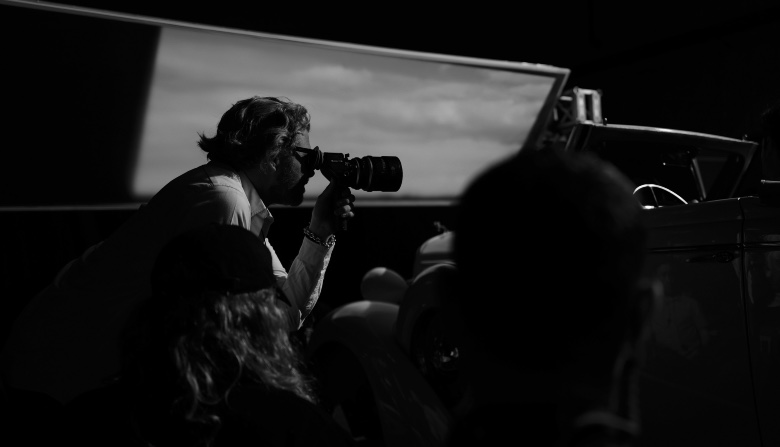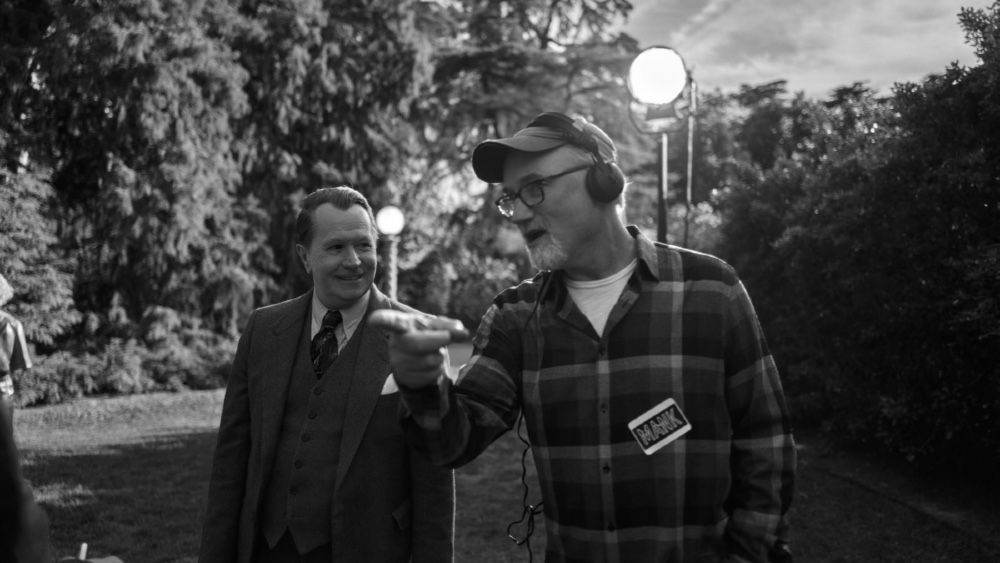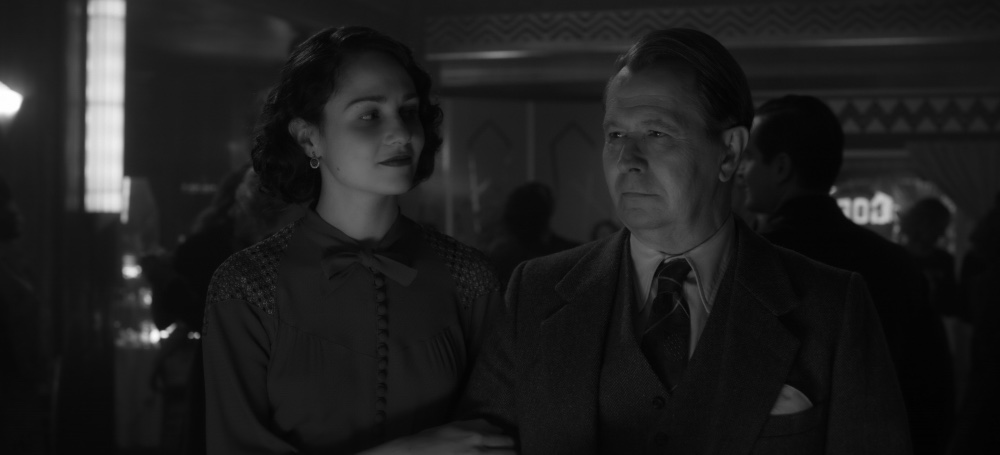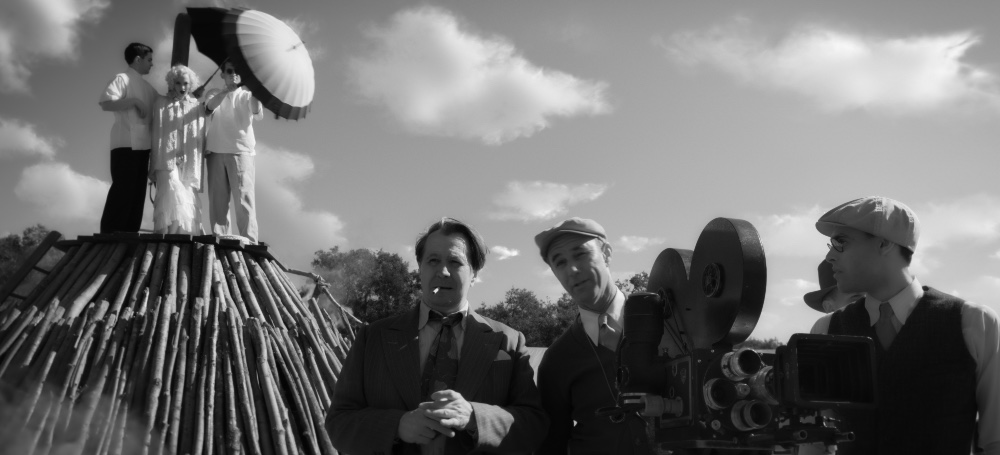
Whenever David Fincher releases a new film, it’s a joy for cinephiles and filmmakers alike to see how the Oscar-nominated filmmaker has stretched the boundaries of filmmaking. His latest Netflix film Mank is no exception.
For the film shot all in black and white, Fincher teamed with his Mindhunter Cinematographer Erik Messerschmidt, and people have been quite awed by his camera and lighting work being that it’s his first film credited as a Cinematographer. That’s only part of the story – we’ll let him tell the rest – but the young DP has paid his dues by rising up the ranks through the electrical side of things.
Either way, the results are amazing as Fincher works from a script written by his late father, Jack Fincher, to tell the presumably fictionalized story of Herman Mankiewicz (Gary Oldman), the well-regarded Hollywood screenwriter whose many relationships during the ‘30s, led to the initial script that would eventually become Orson Welles’ Citizen Kane. Fincher’s film explores the way Mank viewed the relationship between mogul William Randolph Hearst (Charles Dance) and his girlfriend and ingenue Marion Davies (Amanda Seyfried) and molded that into Kane, all while battling his demons in a bottle with the help of his helper Rita (Lily Collins).
Below the Line got on Zoom with Mr. Messerschmidt a few weeks back to talk to him about what went into making such a gorgeous black and white film that stands next to Welles’ great cinematic masterpiece.
Below the Line: I looked over your IMDB page as research, and you’ve definitely come up the ranks, doing every job within camera before becoming a cinematographer. Maybe we can start by you talking about your background and schooling a bit?
Erik Messerschmidt: I went to film school. I was a young and ambitious and excited student, who came out of film school thinking he was going to be a cinematographer, like the first day out of film school and quickly learned that I was not, and I was not who I thought I was. I was very fortunate to meet a number of people who took pity on me and and were willing to exploit my ambitions for their own good [laughs] — that’s tongue in cheek. No, I met some cinematographers or gaffers and key grips, who introduced me to cinemaphotographers. I worked my way up really through the electrical department, and I became a gaffer. I was a gaffer for a long time, and I worked for some great cinematographers, and that’s really where I kind of cut my teeth. I did it a bit of the hard way, you might say.
BTL: I feel like many of the cinematographers I’ve spoken to did just come out of school and they’re shooting a movie, so it’s nice to see someone who worked their way up and paid their dues doing different things. I’m sure a lot of people are talking about this being your first movie as a cinematographer, although you’ve done a lot of other things as well. You worked on Mindhunter as a cinematographer, though you didn’t work on David’s first two episodes?
Messerschmidt: I shot about half of those two. We did a lot of reshoots, David and I together, so I’m not technically credited on those episodes – well, I’m credited as additional photography — but David and I reshot about half of those first two together, and then the rest of the series.

BTL: At what point did he tell you about or show you the script for Mank? Was it fairly organic to come over and shoot his next film, as well?
Messerschmidt: David and I, we had formed a pretty good shorthand over the years, and Mindhunter was a long process. The two seasons of the show ended up being almost three years of work, so we spent a lot of time together. I had done Gone Girl as the gaffer with Jeff Cronenweth, who shot Gone Girl, and I was his gaffer on that movie, so I knew David quite well. When he presented me with Mank… When he first asked me about it, he didn’t have the script ready – he just told me about the story. He said, “I’m going to do this black and white movie, I want you to shoot it.” I was like, “Great. That sounds fantastic. I’m in. Can I read the script?” He sent it to me probably six weeks later. In the process before reading the script, I had put together all these ideas of what I thought black and white movies were supposed to be. I sent him images, and I was like, “What about this? What about this? What about this?” Then I read the script, and I was like, “Oh, okay. Let me revisit all that stuff.” The movie really came out of those conversations after that initial process.
BTL: Did you at least know what the movie was about?
Messerschmidt: I did. I kind of knew it peripherally. It’s a movie that he’s been trying to make for 30 years. It was something I knew was on his radar, and that he talked about in passing. I didn’t know about the Upton Sinclair tie-in. I had associated [Mank] more with Citizen Kane than the movie is really about, of course. Citizen Kane is just sort of the catalyst for the story. It’s a much different story than that. People like to associate it with Citizen Kane, of course, but that’s not really the story we’re telling. I had made misconceptions initially just sort of imagining what the story was, and then I read the script. Of course, I had a much better idea what it was we were going to set out to do.
BTL: I think my misconception is that you watched Citizen Kane a thousand times, read every single book to find out how it was made. I assume that’s not the case at all?
Messerschmidt: I was a student of Citizen Kane. I’ve studied Gregg Toland, and I was a cinematography student, and I studied film theory and American cinema. Over the years, of course, the lore of that film perpetuates through the cinematography community still. There were specific things we certainly wanted to reference, particular to that film: the deep focus aspects of the film, certain compositional techniques that were done, and there’s some structural similarities in the script, and the way the story is told with the flashbacks and the way we transition between scenes. Things like that are referential, but I think the movie is much more of a culmination of the black and white cinema, the period and also modern black and white cinema, as well. It’s a little bit of a cacophony of technique, depending on what’s happening on screen.
BTL: Was shooting on film ever part of the conversation?
Messerschmidt: No, it wasn’t. We talked about the things we liked about the film, and the result of shooting on film. We often quite like the results of shooting on film, but not particularly the process of shooting film, if that makes sense. Don’t get me wrong. I adore film, but on this particular project, it was not the right medium for us in terms of what we knew we wanted to accomplish and how we wanted to work on the set. But we talked a lot about what film looks like, what film of the period looks like. Of course, modern film, by the way, replicate cinema of that period either, so in that regard, it isn’t even the right choice. We talked a lot about what movies of the period looked like, and what their grain structure was, and what the lighting technique was, and how the post process works, and certain effects that we liked. We had long conversations around flares and highlights. I mean, it could get quite esoteric if you want.

BTL: This is the right place to get into that kind of stuff.
Messerschmidt: Sure. I mean, we really broke it down. It wasn’t like we had long drawn-out conversations, but a lot of it was images that we would send back and forth. For example, I had watched The Big Combo, as a reference, and I had seen these halation flares, which are particular to that period — the late 30s, early 40s, lenses of that period have certain flair characteristics that are very difficult to replicate with modern lenses. You get these halos around highlights, and I sent the references to David and I said, “I think we should really try and do this.” And he said, “Oh, that’s interesting.” We had done quite a bit of work on Mindhunter with digitally-painted flares, which was a process we loved, really getting to art direct it and be very specific about it. I sent them to him, and he quite liked the idea and he sent them to the post people and VFX people and they started to process out tests for us, and they sent us tests, and then we shot tests and then they painted on top of them — things would go back and forth. Everything in the movie is a bit of that. We shot exhaustive lens tests, for example. I looked at dozens of different sets of lenses and how they performed deep stops and where we’d get the maximum depth of field and what their resulting resolution characteristics were, etc. We really worked quite hard to kind of distill all those things down into the movie we wanted to make. The one place I feel really good about the movie is that I feel quite strongly that the movie we made is the movie we set out to make. It wasn’t like we accepted anything we didn’t expect or didn’t want. We got pretty much what we said we wanted, which doesn’t happen very often, you know.
BTL: I feel that David is like that in general, though. I feel he’s very meticulous about knowing what he wants and makes sure to get them. Did you use a lot of old school lighting or camera techniques, or things that hadn’t been done in a long time?
Messerschmidt: Yeah, we did. The techniques of the period are quite broad, the strokes are quite broad, particularly with lighting. The lighting sources tend to be single source or just a couple sources and lots of hard light, not a lot of soft light. There are moments in the movie in the movie where we do it particularly in the flashback sequences, like the interiors of the studio when he’s in Irving Thalberg’s office, for example, or [when] Mayer walks in and addresses the employees of MGM. Those are sort of classically lit black and white shots. What we might say are the present-day sequences in the movie, like the stuff in Victorville in the bungalow, and to some extent, technically — even though they’re flashbacks, the sequences at Hearst Castle are slightly more modern in their technique. That was something we are interested in exploring, or at least I was, in terms of trying to differentiate time period in the film, which is always part of the conversation when you’re jumping in time back and forth in the cut. When it felt appropriate, we would lean into the period more and when it felt too much or too stylized, we’d pull it back a little bit. That was something I was very conscious of, and cautious about, because you don’t want it to be a parlor trick or draw attention to yourself.
The thing I was really scared of was that people would turn the turn the film on, and they wouldn’t see past the fact that it was black and white. That was the hope was like within five or six minutes of watching the movie, they would forget that they’re watching a black and white movie and just enjoy the film and then they could go out and go back a second time and see what we did, if they were interested, but it wasn’t going to linger. Films like this, you run the risk of becoming parodies of themselves a bit, or at least they are too referential of a period, and it becomes a little bit exploitive if you’re not really careful. That was something I was personally quite conscious of and concerned with.

BTL: Is most of this movie soundstage work with no natural lighting? There are some scenes that are obviously outdoors, but even those feel like they could have some CG work later.
Messerschmidt: It’s a mix. No, I would say there’s probably more location work than typical with David, at least the the previous projects I’d done with him. Most of the interiors are done on stage — the Victorville bungalow interiors were done on stage, the Hearst Castle interiors were done on stage. They built those sets — did beautiful work on building those sets. They’re quite spectacular. It’s actually one of those examples of a set [where] it’s like, “God, I’m glad we did the movie in black and white but I kind of wish people had seen this set in color,” because it was really beautiful. There’s interiors at Paramount that were done on stage and the interior of the MGM soundstage, obviously, was a location, but technically inside. But the exteriors, with the exception of the Mank-Marion meet-up with the limo, when they’re sitting on the log, that’s actually done in front of an LED wall. It was because the scene was quite long, and the location we had just did had a freight train that passed every eight minutes, so it was not realistic. That was done on stage. The night exterior walk and talk with Marian and Mank at Hearst Castle was done Day for Night actually, so that was kind of fun and interesting.
BTL: What are some of the challenges of making a black and white movie? Do you have a monitor where you can actually see it in real time in black and white while filming it?
Messerschmidt: We made the film with a black and white camera, so the camera only records black and white color. It wasn’t like we shot color and then desaturated it later. The movie only ever existed in black and white for us. RED makes a camera for it, and it’s fantastic. I can’t imagine doing it another way. We did monitor it in HDR, which is something I had been doing for the last several years but is not that common, which is something I’m just obsessed with. It’s completely changed the way I work for the better, I think. That was a new thing to do. I don’t know that anyone’s done that in black and white before, but it was quite exciting and helpful. But I mean black and white is interesting, because [with] color, you can somewhat predict how certain colors will resolve on camera when you choose color. You have a pretty good idea of how reds are going to resolve and how yellows are going to resolve. If you’ve done some post tests you know how much saturation you can handle, and so forth. In black and whites, two different shades of green can look vastly different on camera than they do to your eye. Probably the biggest challenge we faced was determining which colors would work well in conjunction with the others. That was prep I did with Don Burt, Production Designer, and Trish Summerville, the Costume Designer. The three of us really got together quite a bit in the prep and looked at things together and tested different tonal combinations.
It’s one of those things where Trish could put someone in a brown suit, and Don could have a green wall, and [if] you put someone in a brown suit in front of a green wall in black and white, they completely blend. So the three of us spent a lot of time together, comparing notes and talking about what we were going to do where and how much light I was gonna use, or if I was gonna use backlight and what these people are going to be wearing and what the walls would be. That was really fun, because it was a type of collaboration that you always do, but not to the extent we did on this movie. So the three of us got quite close on the film, which was really nice, because we worked really closely together.
BTL: Were they able to be involved in doing the lens and camera tests with you?
Messerschmidt: Oh, yeah, absolutely. I mean, there’s a scene in the movie where Charlie Letterer goes and meets Joe Mankiewicz in the bathroom at Paramount. I don’t know how much time you’ve spent on the Paramount lot, but all the bathrooms at Paramount, they all have green tile, and they always did, as I understand it. Don Burt had done a lot of research, and he said, “Yeah, most of that tile is original.” So we looked at… I mean, we must have looked at 40 different tones of green tile. There was a tremendous amount of testing.
BTL: Were you finished with post and everything before COVID hit?
Messerschmidt: No, we wrapped the movie, I think it was like the 21st of February of last year. It was two weeks later when the lockdown was, so we did the post remote, which is not new for David. I mean, he’s been doing that for years, so he’s quite comfortable, actually, and we did the entire grade remotely. We had done both seasons of Mindhunter that way as well. So that was not a new thing for us. We were quite comfortable doing that, actually, but it’s a little strange if you had a question not being able to go into the suite and take a look on a Thursday afternoon — drop by and take a look — but yeah, everything was done remotely. I mean, I think they even did the sound mix remotely. I don’t know for sure. But yeah, we did the post all through the summer.
BTL: Your next project you’re doing with J.D. Dillard (Sleight) — Is that starting fairly soon?
Messerschmidt: I am. Our first of the three days of camera tests started today, and we start shooting the principle on Monday. I’m in Savannah, Georgia right now, and we’re right in the thick of it.
BTL: Do you have to wear face shields and PPE and stuff like that?
Messerschmidt: Yeah, PPE, and a lot of testing. We’re tested a lot, and of course, everyone’s just wearing masks and socially distancing. We’ve managed to do pretty well, actually, with it all, I think. Wish us luck!
BTL: I spoke to another cinematographer who has had to wear a face shield over his glasses, which makes it harder to do your job as a cinematographer. You have to find new ways of doing things.
Messerschmidt: It really is. I had shot the final episode of Fargo this year, and we shot in October or August, I guess it was. We were one of the first shows to go back to work, and it was really challenging with the shield. It’s very difficult, because you look at monitors all the time and bright lights and they flare, and you can’t really tell, and also communication is a challenge. We’re always whispering to each other and trying to get things to happen behind the scenes, and you’re behind a mask and a face shield, and you’re trying to communicate something quietly to a producer or camera assistant or dolly grip without the entire crew hearing you, so you got to find new solutions for that sort of thing.
BTL: At least when you’re done with this, everything will seem much easier, because you’ve figured out how to do things in the hardest possible circumstances.
Messerschmidt: True, true. Necessity is the mother of invention.
BTL: I’m curious about working with David, since you’ve done so much with him now. He’s known for being very demanding and wanting to get a lot of coverage. You’ve done a movie with him and many episodes of the TV series, do you find these are similar experiences?
Messerschmidt: I would say it’s very similar. You know, David always gives 150%, so it’s not like he lets up on a TV show. He’s incredibly invested, and it’s inspiring to be around. I think David, he’s trying to improve every shot, and he’s incredibly collaborative and supportive and thoughtful and curious, and his tenacity is infectious, so I love working with him. I mean, I think we have a really good relationship, and it’s very open, and we’re in a creative place where we can challenge each other. He certainly challenges me and pushes me to improve my work, and he’s one of those people who allows you to never accept your second best which is a wonderful place to be as a cinematographer. Only your best work is accepted, which is great.
Mank can now be watched on Netflix.
All photos provided by Netflix. Click on images for larger versions.





